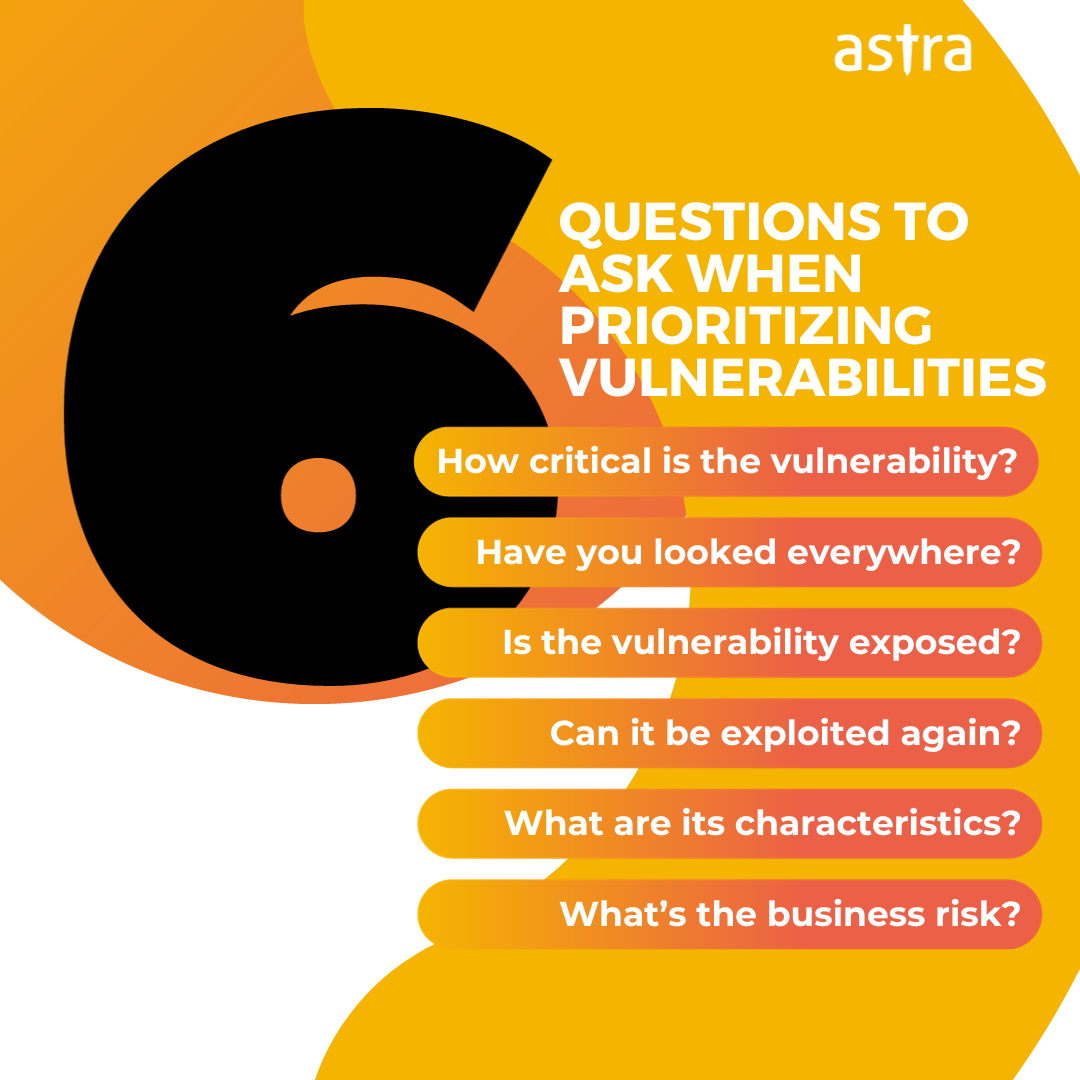The scale of vulnerabilities identified today has made identification a seemingly endless challenge. Traditional management programs tend to adopt an ‘everything is a risk’ approach. This will easily lead to overwhelmed IT teams. IT teams should refine their remediation methods to enrich vulnerabilities with business context, threat intelligence, data science, and machine learning. Companies should utilize this data to prioritize vulnerabilities that are most likely to be exploited causing most harm to the organization’s digital infrastructure.
Traditional vulnerability management is a broken system that does not effectively reduce risk. Establishing a risk based vulnerability management program enables organizations to properly identify, prioritize, and remediate vulnerabilities in your digital infrastructure. A risk-based approach to vulnerability can be implemented by completing an asset inventory, conducting a risk assessment, calculating risk weighting, and aligning processes to mitigate risk.
What is Risk Based Vulnerability Management?
Risk based vulnerability management (RBVM) helps identify and manage risks that threaten your digital assets. It uses machine learning to associate vulnerability severity and threat actor activity with asset criticality. This will help you prioritize and remediate the ones that cause the greatest risk to your digital infrastructure.
RBVM is an improved version of traditional vulnerability management as it prioritizes each vulnerability’s risk score using combined inputs that considers the location of each vulnerability enriched vulnerability score metrics. vulnerability and risk management takes the basic risk equation – Risk = Threat * Probability and adds contextual risk a vulnerability poses to an organization.
Vulnerability and risk management takes into account inputs such as:
- CVSS score and vector
- Location of a vulnerability within your digital infrastructure
A threat-based risk score will give you more context to apply limited IT security resources more effectively and efficiently in remediation steps.
Why should you switch to Vulnerability risk management?
Malicious actors will most likely have the goal of maximum damage to your digital assets. They take a strategic approach attacking vulnerabilities that are most likely to provide access to your critical systems and data.
Assuming vulnerability and risk management approach ensures that you are protecting your critical assets.
Benefits of Vulnerability risk management
- Increased focus on risk: Vulnerability risk management helps you quantify and qualify where cyber risk exists and tend to risk hotspots first and with as many resources as possible for better and quicker remediation.
- Increased accuracy: Vulnerability risk management enables you to make faster, more informed, data-based security decisions. This leads to a proactive approach that allows the IT team to focus time and resources on the most critical vulnerabilities.
- Increased visibility: Vulnerability risk management guarantees visibility to all assets across the attack surface. This includes modern assets such as mobile devices, cloud applications, etc which are often not supported by legacy systems.
- Continuous protection: A modern RBVM tool continuously scans and monitors your digital environment. This will help you detect vulnerabilities as they evolve and ensure overall security posture.
- Efficiency gains: Vulnerability risk management leverages modern tech to automate every aspect of the assessment process thereby reducing human error. This allows your team to streamline recurring activity and focus on high-value activities.
- Better reporting: Vulnerability risk management delivers actionable vulnerability and risk management insights. RBVM also gives an enriched context to each vulnerability to optimize deployment of InfoSec personnel. This in turn saves time and has a bigger impact on defensive security, delivering a better return on security investment (ROSI).
What is the difference between vulnerability risk management and traditional vulnerability management?
The first step to understanding the difference between RBVM and traditional vulnerability management is understanding the definitions of the terms that are often used interchangeably:
- Vulnerability is defined as “a weakness of an asset or group of assets that can be exploited by one or more threats.”
- Threat is something that can exploit a vulnerability.
- Risk is what happens when a threat exploits a vulnerability.
Risk-based vulnerability management doesn’t just vulnerabilities (like legacy vulnerability management). It proactively comprehends vulnerability management risks and with threat context and potential business impact.
| Vulnerability risk management | Traditional vulnerability management |
| Assesses and analyzes the entire attack surface | Assesses only legacy digital assets such as desktops, network devices, services etc. |
| Prioritizes vulnerabilities based business context and risk probability | Categorizes vulnerabilities based on CVSS score |
| Dynamic and continuous visibility | Static, point-in-time scoring methodology |
| Drives data-backed decisions to maximize risk reduction | Checks minimum compliance |
| The process is proactive and ensures that you are protected even before an attack occurs | The process is reactive |
How to prioritize vulnerability management risks?
CVSS scores alone are not enough to understand the severity of vulnerability management risks. Cyber exposure analysis and scoring weighs vulnerabilities, threat data, and your business impact and criticality. Instead of being limited to vulnerability data, you need to focus on context-relevant exposure scoring methodology.

How to implement Vulnerability risk management?
The modern threat landscape requires a risk based vulnerability management program that has more accurate methods for categorizing vulnerabilities according to the actual risk they pose to an organization to keep pace with the evolving threat environment.
4 critical initial steps to implement a risk based vulnerability management:
- Identify and inventory all your assets across your attack surface. In this audit, include all known and unknown assets such as cloud, IoT, OT, containers, etc. Utilize tools such as network scanners, asset discovery solutions, or cloud security posture management solutions.
- Assess and prioritize vulnerabilities and weaknesses on your assets based on the risk they pose. You can use tools such as vulnerability scanners, threat intelligence platforms or vulnerability and risk management solutions for this. Here, you should consider factors such as asset criticality, vulnerability severity, exploit availability, threat actor activity, and business impact.
- Remediate high risk vulnerabilities and weaknesses as soon as possible. Analyze the vulnerability to understand the appropriate methods for each asset type and vulnerability type. You can use tools such as patch management solutions, configuration management solutions, or automation platforms. It is important to track and measure the effectiveness of your remediation efforts and report on the progress and outcomes.
- Continuously and dynamically keep repeating the above steps as your attack surface and threat landscape changes. You should also review and update your vulnerability and risk management policies and process regularly to ensure they align with your organizational goals and security best practices.
How to measure the effectiveness of your Vulnerability risk management program?
To measure the effectiveness of your RBVM program, you should define and track some KPIs that reflect your RBVM goals and objectives.
Some examples of Vulnerability management risks KPIs are:
- Vulnerability risk score: This metric quantifies the risk level of each vulnerability based on factors such as asset criticality, vulnerability severity, exploit availability, threat actor activity, and business impact. This score can be used to prioritize vulnerabilities for remediation and compare the risk levels of different assets or groups of assets.
- Mean time to remediate (MTTR): This metric measures the average time it takes to fix a vulnerability from the time that it is discovered. This can also be used to evaluate the efficiency and effectiveness of your remediation efforts and identify and bottlenecks that need to be addressed.
- Remediation coverage: This is a metric that measures the percentage of vulnerabilities that have been fixed out of the total number of vulnerabilities discovered. You can also use this metric to assess the completeness and quality of your remediation efforts and identify any gaps or areas for improvement.
- Remediation rate: This metric measures the number of vulnerabilities fixed per unit of time of your choice. You can use this to monitor the progress and performance of your remediation teams and resources and adjust your plans accordingly.
- Risk reduction: This measures the amount of risk that has been eliminated or mitigated by fixing vulnerabilities. It helps you demonstrate the value and impact of your RBVM program on your organization’s security posture and business objectives.
Risk based vulnerability management best practices
1. Match your vulnerability management strategy with your risk tolerance level
Every organization has an upper limit on how much you can handle and at the speed at which you handle vulnerabilities. This is driven by your organization’s:
- Capacity for operation risk
- IT operational capabilities
- Ability to absorb disruption
Creating digital visibility is an important step in developing a vulnerability management program and reliably managing vulnerability management risks. A full inventory of systems and data, hardware and software, and a network topography in hand ensures your scanning and other security tools have visibility of all critical assets in the environment.
This complete inventory of all systems and data is important to conduct a risk assessment and a risk based vulnerability management program capable of:
- Prioritization of vulnerabilities
- Optimization vulnerability management activities
- Reduction of exposure time of critical vulnerabilities
2. Prioritize vulnerabilities based on risk
You need to implement multi-faceted, risk based vulnerability prioritization, based on factors such as:
- Severity of the vulnerability
- Current exploitation activities
- Business criticality
- Exposure of the affected system
One of the biggest changes to implement is to focus on vulnerabilities that are being exploited in the wild. This will drive down the most risk quickly. A full and proper risk assessment of your digital infrastructure includes the critical consideration of how each asset impacts an organization’s overall business operations.
A security risk assessment should identify assets that are critical such as:
- Revenue generating activities
- Identify sensitivity labels for all data
- Data protected by regulations
- A component in a cyber-insurance or compliance requirement
3. Align processes to mitigate risk
You can improve your security posture by combining remediation solutions like patch management tools and compensating controls that can provide virtual patching like web application firewalls and intrusion detection and prevention systems. These help you mitigate vulnerabilities more efficiently and reduce the operational impact on your organization.
Newer technologies like breach and attack simulation (BAS) tools can also be used to evaluate the effectiveness of your existing security technologies and understand their security capabilities against threats like ransomware.
Sometimes, you might not be able to patch a system due to various reasons such as lack of vendor support, software compatibility issues or regulatory constraints. It is important that you are reliant solely on patching as your strategy against security threats. A better risk based vulnerability program can help shrink your attack surface significantly making it harder for a malicious actor to exploit your environment.
4. Use technologies to automate vulnerability analysis
Use technologies that can automate vulnerability analysis to speed up and enhance your remediation process. Check your current vulnerability assessment solutions and ensure they can handle new types of assets like cloud, containers and cyber-physical systems in your environment. If they cannot, upgrade or change the solution.
Automating vulnerability analysis is important in a risk-based vulnerability management approach because it can help you:
- Achieve consistent and accurate risk assessment of your vulnerabilities across your attack surface.
- Proactively identify and remediate vulnerabilities before they are exploited by cybercriminals.
- Save time and resources by streamlining the vulnerability scanning and prioritization process.
- Reduce human errors and improve compliance with security standards and regulations.
- Enhance your security posture and reduce your attack surface by focusing on the most critical vulnerabilities.
Follow these steps to implement automation in your risk based vulnerability management approach:
- Choose an automation tool that can integrate with your existing vulnerability management tools, such as scanners, ticketing systems, CMDBs, threat feeds, etc. This will help you streamline the data collection and analysis across your attack surface.
- Configure the automation tool to scan your assets for vulnerabilities on a regular basis, preferably daily or weekly. You can also set up triggers to launch scans based on events, such as new asset discovery, patch deployment, or threat alert.
- Define your vulnerability prioritization criteria based on factors such as asset criticality, vulnerability severity, exploit availability, threat intelligence, and business impact. You can use a risk-based approach to rank your vulnerabilities according to the level of risk they pose to your organization.
- Automate the creation and assignment of tickets for the high-risk vulnerabilities that require remediation or mitigation. You can use a grouping algorithm to group vulnerabilities by similar attributes, such as vulnerability type, operating system, location, etc. This will help you reduce the number of tickets and optimize the remediation workflow.
- Automate the verification and validation of the remediation or mitigation actions. You can use the automation tool to rescan the assets after the tickets are closed and confirm that the vulnerabilities are resolved. You can also use the tool to generate reports and dashboards to track and measure your vulnerability management performance.
Why is Astra Vulnerability Scanner the Best Scanner?
- Runs 8000+ tests with weekly updated scanner rules
- Scans behind the login page
- Scan results are vetted by security experts to ensure zero false positives
- Integrates with your CI/CD tools to help you establish DevSecOps
- A dynamic vulnerability management dashboard to manage, monitor, assign, and update vulnerabilities from one place.
- Helps you stay compliant with SOC2, ISO27001, PCI-DSS, HIPAA, etc.
- Integrates with Slack and Jira for better workflow management
- Trusted by the brands you trust like Agora, Spicejet, Muthoot, Dream11, etc.

Conclusion
The threat landscape is constantly updating. It is important for companies to also evolve and take a proactive approach to security. Gartner has forecast that the rapidly growing market for risk-based vulnerability management tools will reach $639 million by 2023. Risk-based vulnerability management (VM) is the process of finding, ranking and fixing cyber vulnerabilities based on how much they threaten a specific organization. Vulnerability management has evolved over time in the complex world of cybersecurity. It started with organizations scanning their systems against a database of known vulnerabilities, misconfigurations and code flaws that could expose them to attacks.
Frequently Asked Questions (FAQs)
What is the formula for risk-based vulnerability management?
The improved risk formula, Risk = Criticality (Likelihood × Vulnerability Scoring [CVSS]) × Impact, shows that it can produce more accurate and effective risk ratings, which are based on the three dimensions (likelihood, vulnerability scores and impact).
How do you calculate the risk formula?
There are 3 formulae:
Risk = Likelihood x Severity
This formula states that risk is the product of the probability of an event occurring and the impact if it occurs. Likelihood and severity are assigned values between 1 & 3 or 1 & 5 resulting in a risk matrix.
Risk = Probability x Consequence
This formula states that risk is the product of the chance of an event occurring and the outcome of the same. Probability and consequence are presented as percentages or fractions resulting in a risk score.
Risk = Criticality x (Likelihood x Vulnerability Scoring)
This states that risk is the product of the importance of an asset, the chance of a threat exploiting a vulnerability and the severity of the same. All the terms are based on factors such as asset value, threat intelligence, exploit availability, and CVSS.
What are the 4 stages of vulnerability management?
An effective vulnerability management process requires four continuous stages: identification, prioritization, remediation, and reporting. A vulnerability is a defect or weakness in a system that, if exploited, would let a user gain unauthorized access to launch an attack.
What is CVE in vulnerability management?
CVE stands for Common Vulnerabilities and Exposures. It is a list of publicly disclosed information security flaws that have been assigned a unique identifier by a CVE Numbering Authority (CNA). CVE helps vulnerability management by providing a common language and reference for identifying and prioritizing vulnerabilities across different systems and products.
















